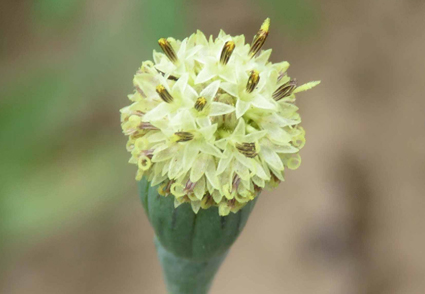Abstract
Porophyllum riparium, a new species of the genus Porophyllum, is described. Morphological details, illustration, geographical distribution, and photographs in its natural habitat are provided. This new species occurs in the northwest region of Argentina, in Salta, Jujuy and Tucumán Provinces, in the Yungas biogeographical province. It is usually found on rocky and sandy soils, as well as along riverbanks. Porophyllum riparium is characterized by being an annual or short-lived perennial, glaucous, odoriferous, monoecious herb, 15–80(–130) cm tall, with sessile or attenuate into a pseudopetiole, linear-elliptic leaves with submarginal and subapical semi-pellucid oil cavities, lemon-colored infundibuliform corollas and exserted brownish anthers. Additionally, female plants of Porophyllum cabrerae were documented for the first time, photographs and descriptions of their female florets are included. Also, a key to identify northwestern species of Porophyllum is provided.
References
- Anzuinelli, M. & Bartoli, A. (2024) Porophyllum iruyense (Asteraceae: Tageteae), a new endemic species from the north of Salta Province, Argentina. Phytotaxa 636 (3): 238–245. https://doi.org/10.11646/phytotaxa.636.3.4
- Arana, M.D., Natale, E., Ferretti, N., Romano, G., Oggero, A., Martínez, G., Posadas P. & Morrone, J.J. (2021) Esquema biogeográfico de la República Argentina. Opera Lilloana 56: 1–238.
- Arduino, P. (1764) Animadversionum Botanicarum Specimen Alterum. Typographia Sansoniana, Veneza, 42 pp.
- Beentje, H.J. (2010) The Kew Plant Glossary: An Illustrated Dictionary of Plant Identification Terms. Kew Publishing, Royal Botanic Gardens, Kew, 164 pp. https://doi.org/10.1111/j.1095-8339.2010.01099.x
- Candolle, A.P. de (1836) Prodromus Systematis Naturalis Regni Vegetabilis. Treuttel & Würtz, Paris, 706 pp. https://doi.org/10.5962/bhl.title.286
- Carneiro, C.R, Schneider, A.A & Ritter, M.R. (2014) Porophyllum spathulatum (Asteraceae: Tageteae), a new species from the southern Brazilian coast. Phytotaxa 173 (2): 157–162. https://doi.org/10.11646/phytotaxa.173.2.6
- Cassini, H. (1819) Sixième mémoire sur la famille des Synanthérées, contenant les caractères des tribus. Journal de Physique, de Chimie, d´Histoire Naturelle et des Arts 88: 150–163.
- Guettard, J.E. (1754) Huitième mémoire sur les glandes des plants, & le septième sur l’usage que l’on peut faire de ces parties dans l’établissement des genres des plantes. Histoire de l’Académie Royale des Sciences 1750: 345–384.
- Hind, D.J.N. (2000) A New Species of Porophyllum (Compositae: Heliantheae) from Argentina. Kew Bulletin 55 (2): 387–391. https://doi.org/10.2307/4115650
- Hind, D.J.N. (2002) A new species of Porophyllum (Compositae: Heliantheae) from Bahia, Brazil. Kew Bulletin 57 (3): 705–709. https://doi.org/10.2307/4111003
- Hind, D.J.N. (2020) Porophyllum woodii (Compositae: Heliantheae: Pectidinae), a new species from Prov. Burnet O’Connor, Departamento de Tarija, Bolivia. Kew Bulletin 75: e61. https://doi.org/10.1007/s12225-020-09915-2
- IUCN Species Survival Commission (2012) IUCN Red List categories and criteria, version 3.1. Gland: IUCN. [https://portals.iucn.org/ library/sites/library/fles/documents/RL-2001-001.pdf]
- IUCN Standards and Petitions Committee (2019) Guidelines for Using the IUCN Red List Categories and Criteria, version 14. Prepared by the Standards and Petitions Committee. [http://www.iucnredlist.org/documents/RedListGuidelines.pdf]
- Jacquin, N.L. (1760) Enumeratio Systematica Plantarum, quas in insulis Caribaeis. Inter Documentation Company AG, Zug, Switzerland 8: 28.
- Johnson, R.R. (1969) Monograph of the plant genus Porophyllum (Compositae-Helenieae). The University of Kansas Science Bulletin 48 (7): 225–267.
- Novara, L.J. & Petenatti, E.M. (2000) Asteraceae – Tribu 6. Helenieae. Aportes Botánicos de Salta—Serie Flora, 6 (8). Flora del Valle de Lerma, pp. 1–46.
- Petenatti, E.M. & Espinar, L.A. (1997) Asteraceae, parte 6. Tribu VI. Helenieae. In: Hunziker, A.T. (Ed.) Flora Fanerogámica Argentina, vol. 45. Programa Proflora (CONICET), Córdoba, pp. 1–34.
- Quantum GIS Development Team (2022) QGIS Geographic Information System. Open Source Geospatial Foundation. http://qgis.org
- Thiers, B. (2024 [continuously updated]) Index Herbariorum: A global directory of public herbaria and associated staff. New York Botanical Garden’s Virtual Herbarium. Available from: http://sweetgum.nybg.org/ih/ (accessed 1 January 2024)


